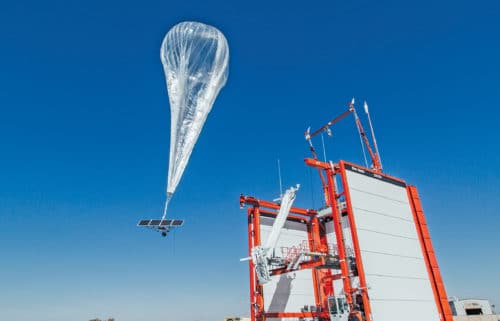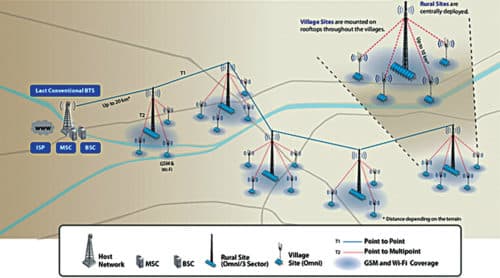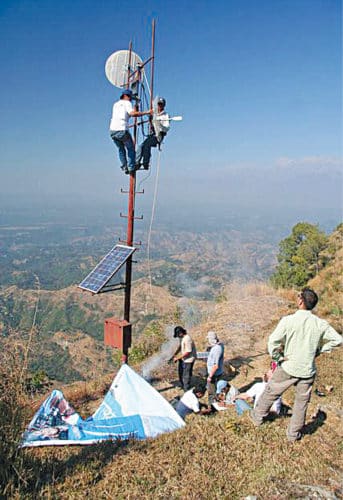Take a look at the many options that are being considered globally to connect remote areas affordably
At a time when we use the Internet for everything from communications and education to shopping and navigation, millions of people across the world live several kilometres away from base stations without access to mobile networks. In rugged terrains and interior regions, laying cables is also too costly, making broadband connectivity impossible. According to a UN report, this leaves nearly half the world’s population ‘unconnected’!
However, people in remote areas need the Internet as much as us. Farmers can use the Internet to manage their crops better and sell their produce. Rural artisans can peddle their ware directly instead of selling cheap to middlemen. Education, women empowerment, economy, healthcare, sanitation and many other facets of life will get a positive spin. This makes it imperative to connect the rest of the world’s population to this magical realm called the Internet.
But, that’s easier said than done. It will take years to extend the kind of communications infrastructure we have in cities and towns to remote areas—because of the difficulties posed by weather and geographical terrains, the sheer cost of setting up cable or mobile networks across hundreds of kilometres, learning curves involved in using the infrastructure, poor economy of scale, slow returns on the investment and more of such risks.
As a result, governments, researchers and socially responsible corporates have started exploring alternate methods to connect remote areas across the world. From hoisting mobile infrastructure on hot-air balloons and drones, to using vacant television bandwidth for connectivity, a lot of mind-boggling ideas are being explored.
The Indian government is also working towards similar goals with its Digital India campaign. Although progress seemed slow initially, it has taken conscious efforts last year to speed up the related infrastructure development. Connectivity to Indian villages was one of the key focus areas of Budget 2017. Last year, Minister of Communications, Manoj Sinha announced that all 250,000 Gram Panchayats in India will be connected to the Internet by December 2018 under the BharatNet project. Earlier known as the National Optic Fibre Network or NOFN, this project will cost ₹ 100 billion. Along with optical fibre networks, Wi-Fi hotspots are also being set up in every village.
Realising the potential of a connected population, Internet majors such as Facebook, Microsoft and Google are all eager to pitch in with their innovative technologies to connect rural India. But, the Indian government is being selective and careful in accepting proposals. For example, Facebook’s initial attempt to connect rural India through the Free Basics program was stopped by the Telecom Regulatory Authority of India (TRAI) as it allowed access only to certain content, in contrast with the principles of net neutrality.
Recently, Microsoft’s attempt to use whitespace (unused television bandwidth) for connectivity in Maharashtra also ran into rough weather because national security agencies thought it was risky to use an unregulated band for last-mile connectivity.
However, enthusiasm has not ebbed and we see these and other companies coming up with fresh ideas! Let us have a look at the many options that are being considered in India and globally to connect remote areas affordably.
Satellites to the rescue
Satellite communication is one of the most effective methods of connecting remote areas. Why? Patricia Cooper, vice president of satellite government affairs at SpaceX, probably explained it best while addressing a US Senate Committee last year. She told that use of a space-based network meant companies didn’t need to install, rip up and reinstall cabling in order to provide a service.
“In other words, the common challenges associated with siting, digging trenches, laying fibre and dealing with property rights are materially alleviated through a space-based broadband network,” Cooper said. This improves reach and reduces cost in the long run, even though the initial setup cost might seem high.
Companies like O3b Networks, OneWeb, SpaceX and Boeing are working towards placing satellite constellations in the low-Earth and medium-Earth orbits so as to reach hitherto unconnected regions in a cost-effective and efficient way.
Recently, Boeing Satellite Systems International entered into a deal to build seven communication satellites for Luxembourg-based SES’ O3b Networks—a project that aims to connect the other three billion people in the world to the Internet. Currently, the O3b constellation has 12 first-generation satellites in the medium-Earth orbit, around 8000km above the Earth. The new satellites being built by Boeing are expected to launch in 2021, and bring 1-terabit Internet connectivity through the O3b network. The entire constellation is expected to cover four-fifths of the Earth’s surface.
Boeing is also working towards a 1000+ satellite constellation that will operate in the low-Earth orbit. Though there has been no official confirmation, it is rumoured that Apple will be a potential investor-partner in this venture.Elon Musk’s company SpaceX is also planning to plant more than 4000 Internet-providing satellites around Earth between 2019 and 2024. After testing a few satellites this year, the company will start manufacturing and launching its satellites into the low-Earth orbit using its own Falcon 9 rockets. The satellites will operate in Ka- and Ku-band frequencies. Placing the satellites at low altitudes of 1110km and 1325km in the low-Earth orbit will help the company save cost and time.
Some experts fear that such a large number of satellites would increase the amount of space junk and make it difficult for companies hoping to place satellites in that orbit in the future. However, the company claims that this will make it easier for everybody to get Internet access, and also the network will be able to adapt to needs, allocating resources to specific areas during busy times and avoiding interference with other systems.
OneWeb hopes to differentiate itself with the affordability and speed at which it can manufacture satellites. The company claims to be building the world’s fastest satellite production facility, which will mass produce satellites just like medical or avionics equipment are manufactured today. Like SpaceX, OneWeb is also targeting the low-Earth orbit.
Last year, the Federal Communications Commission (FCC) approved OneWeb’s proposal to place its non-geostationary satellites at an altitude of about 1200km. Due to this, signals coming from the satellite will have significantly less latency of around 30ms, resulting in much faster communications. Compare this with the 35000+ km altitude for satellites used by traditional Internet service providers (ISPs), causing a latency of 600ms or greater. Starting this year, OneWeb plans to start launching over 700 satellites in association with Airbus. The constellation of satellites will logically interlock to cover the entire planet.
On the Earth, there will be low-cost user terminals that connect to the satellites, and provide long-term evolution (LTE), 3G and Wi-Fi connectivity to surrounding areas. OneWeb hopes to tie-up with existing ISPs and mobile operators to extend their networks into remote rural areas. According to the company, its small cell terminals and core network will be fully 3GPP compatible, so partner operators will be able to use its infrastructure with their current customers, devices and billing systems.
In a news report, FCC Chairman Ajit Pai commented in favour of such satellite constellations: “We hope to approve many more constellations because we know that the more the companies compete, the more consumers win. Additionally, the commission has an ongoing rulemaking proceeding, proposing to update the current NGSO Fixed Satellite Service rules to better accommodate this next generation of systems.”
Delivered through balloons
Google is attempting to provide Internet connectivity to remote areas using high-flying balloons. The idea behind Project Loon, which is part of Google’s Alphabet X research labs, is to suspend a set of huge balloons in the stratosphere at an altitude of around 20km. These balloons will contain the infrastructure needed to provide connectivity up to about 80km by using LTE wireless communications. Loon will share cellular spectrum with telecommunications companies. When users in remote areas access the Internet using their cell phones or other LTE-enabled devices, balloons will relay wireless traffic from these devices back to the global Internet using high-speed links. As of last year, the prototypes provided 15Mbps Internet access.

Google is still working to perfect the way balloons navigate. The stratosphere is made of layers, each having a different wind speed and direction. By moving the balloons up and down to different layers, Google team can make these move to the required region. By coordinating positions of different balloons, they can make balloons work together to cover a region.
According to a recent press report, Project Loon now uses machine learning to predict weather systems and gain greater control over the movement of balloons. It is now possible to focus on a specific region for a long period of time. So far the tests are promising, but the company has still not spoken about a commercial rollout.
In the meanwhile, the Andhra Pradesh government has realised that if not the balloons, the underlying technology can be put to good use right away. The technology being used by Loon is known as free space optical communications (FSOC), wherein beams of light are used to deliver high-speed, high-capacity connectivity over long distances.
AP State FiberNet, a telecom provider in Andhra Pradesh has now entered into an agreement with Alphabet X to use FSOC for providing connectivity to remote areas in the state. This initiative syncs with the Andhra Pradesh government’s AP Fiber Grid programme that aims to connect 12 million households as well as thousands of businesses to the Internet by next year.X Labs will provide 2000 FSOC links and required technical support to deploy them. Each FSOC link will provide 20Gbps wireless Internet connection up to a distance of 20km. FSOC links will help bridge the gaps between major access points like cell-towers and Wi-Fi hotspots, thereby servicing thousands of people each.
… And drones
Facebook hopes to achieve a similar feat by using solar-powered drones. Colloquially referred to as a drone, Aquila is more of an advanced aircraft that weighs over 450kg and has a longer wingspan than a Boeing 747. Its wings are made of cured carbon fibre, which enables accurate moulding to achieve the unique shape of wings.

The aircraft will carry communications equipment as the payload. Signals beamed from it will be received by small towers and dishes that will convert them into Wi-Fi or LTE communication signals. A couple of aircrafts positioned properly will work together to provide connectivity to remote areas, extending the reach of existing telecom networks without setting up new towers, laying cables, etc.
Much to the delight of Facebook’s UK-based aerospace lab, Aquila successfully completed a test flight in Arizona in mid-2017. Following a failed attempt that crash landed in December 2016, the team improved the drone by fitting more sensors, new spoilers, a horizontal propeller stopping system and so on. These improvements helped the drone to stay in the air for close to two hours, reaching a height of roughly 915 metres (3000 feet).
The challenge before Facebook is to make the aircraft stay in the air for months, something that nobody has done so far! They hope that ultimately their solar-powered aircraft will stay up at a height of 18.3-27km (60,000-90,000 feet) for at least three months, providing communication to a 50km communications radius using free space laser communications technology.
In a press report following the successful test, Mark Zuckerberg of Facebook said: “We successfully gathered a lot of data to help us optimise Aquila’s efficiency. No one has ever built an unmanned airplane that will fly for months at a time, so we need to tune every detail to get this right.”
What’s Microsoft up to?
In rural areas, television seems to have spread its wings faster than the Internet. Even in remote villages that have power supply only for a few hours, we hear the television running. In states like Tamil Nadu, governments have promised and delivered televisions to citizens, claiming these to be useful for education and awareness!
Considering all this, Microsoft is hoping to use unused television spectrum or white space to bring broadband to rural areas across the world, including the USA where, believe it or not, more than 30 million people still do not have broadband Internet access.
White space refers to unused spectrum in the ultra-high frequency (UHF) television bands. In other words, this space is the gap between TV channels. Using a database that specifies white spaces and white space radios, local ISPs can utilise the unused spectrum to provide broadband access. Being in the 600MHz frequency range, these non-line-of-sight wireless signals can travel further with less interference than Wi-Fi or Bluetooth. They can reach nooks and corners, across difficult terrain, hills, buildings, etc, making white space the best technology to reach rural communities. Research by Carlson Wireless Technologies has shown that white space Internet can cover a 10km diameter, which is a hundred times further than Wi-Fi.
Since the FCC allowed unlicenced public use of white spaces in 2010, Microsoft and other companies have developed the hardware, software and industry-wide standards to use it for providing Internet connectivity. Microsoft has deployed over 20 TV white space projects in 17 countries, serving over 185,000 users. Citing USA as an example, the company claims that by using a combination of technologies like white spaces and satellites, a country can bridge the rural broadband gap at 80 per cent lower cost than with only fibre cables.
5G can be a big help
An article in theinstitute.ieee.org puts forth 5G as the solution to rural connectivity. It says that increasing the range of telecommunication cells and installing massive multiple-input multiple-output (MIMO) antenna systems at both the transmitter and receiver can help provide connectivity to remote and sparsely populated areas.
Currently, even if people do manage to get a signal 100km away from a base station, they get only a speed of around 10kbps, which is barely enough for voice calls and text messages. With 5G, cells within a radius of 100km will hopefully get at least 100Mbps.
Telecom operators can further increase the transmission power of networks, and hence the speed in remote areas, by using massive MIMO antenna systems at the transmitter and receiver. Further, distributed antenna systems connected via optical fibres will help boost the reliability of 5G connections.With massive MIMO, it is possible to build antenna channels with 100, 200 or 500 elements. By putting together multiple antenna elements in a narrow beam, the energy can be focused accurately in the required direction. As a result, antennae that transmit energy in a 120-degree slice can focus their beam within less than 10 degrees, helping to increase the range and speed.
IEEE Fellow Gerhard Fettweis, co-chair of the IEEE 5G Initiative, explains how this works: “Current cell towers typically point their antennae in three directions. Cut the circle into three parts, and the energy in this one sector could be transmitted no matter how far away a cell phone is. It could receive calls in any place in this sector because only one dedicated antenna is needed to receive the signal. Instead of 10kbps or 100kbps speeds at a 100km radius, 100Mbps will be possible.”
Fettweis also feels that a massive MIMO powered terrestrial system will be less expensive and more effective than airborne systems such as those being built by Google and Facebook. He reminds that companies that built and launched billion-dollar Iridium and Teledesic satellites in the 1990s went bankrupt. Fettweis hopes that 100km radius cells will achieve at least 100Mbps before 2025—a speed that will be tough for an airborne system to achieve.
India on way to becoming truly connected
Considering the Internet as a tool for economic and social development, most developing nations across the world are giving a lot of importance to the Internet access for all. South Africa is one such example that we can readily relate to.
Some months ago, there was a lot of media coverage about a container box that improved the lives of people in remote areas including refugee camps! The so-called container was an innovation by the Computer Aid International. ZubaBox, which means solar-powered box in a local dialect, contains all the essential components for an Internet hub, including communication equipment, laptops and so on. Being solar-powered, the portable Internet hub could be used even in remote villages without power supply. When the ZubaBox arrived in a village, it heralded joy and development for the dwellers!
The South African government is also working with the World Economic Forum to implement Internet for All—a platform project to connect millions of South Africans to the Internet through public-private collaboration.
Connectivity—a prerequisite to achieve Digital India dream
Back home, the Digital India campaign received a lot of impetus in the last budget, and since then we have seen several attempts to not just improve digital literacy but also rural connectivity. Andhra Pradesh is one example. Kerala too has dived into the connectivity challenge headlong and hopes to become one of the most connected states. In fact, the state wants to make Internet connectivity a basic human right.
Developed countries like Sweden and Canada made broadband connectivity a legal right many years ago. In 2016, the United Nations declared that depriving people of Internet connectivity was a human rights violation running contrary to international law. So, Kerala, which is known for being the most literate state, is working on the right lines. It plans to set up a new high-speed optical fibre network called K:Fon, which will run parallel to the existing electricity board network. Using this network, the government will provide free, subsidised or normal tariff Internet connectivity to all people based on their economic stature. Starting with at least one person from each family, Internet access will be gradually extended to all.
Telcos and start-ups at work
Indian telecom operators and start-ups are busy innovating technologies and business models for remote connectivity.
Vihaan Networks Limited (VNL), for example, believes in connecting remote communities using a base engine that is truly optimised and simple enough to be assembled and used by anyone. Their solar-powered WorldGSM Rural Site deploys a cascading star network architecture that enables rural wireless telephony and Internet access in areas with low average revenue per user (ARPU). With minimal capital and operating expenditure, this system gives mobile operators a decent return on investment, thereby enabling even rural operators to venture into this space.

AirJaldi service by class-A ISP Rural Broadband provides high-quality broadband connectivity to rural areas at reasonable rates. You might have read about them providing Wi-Fi services in India’s first digital village Harisal. But, you will be in for a surprise if you look at the kind of remote regions they work in. It is difficult to even locate some of those regions in the Indian map.

RBB owns and operates networks in interior regions of states like Himachal Pradesh, Uttarakhand, Jharkhand, Tamil Nadu, Maharashtra, Bihar and Karnataka. They manage to do this by looking at networks as ‘retail ecologies.’ On their website, they explain that mostly rural areas are subject to partial provisioning of Internet services, typified by the use of singular, non-scalable solutions (for example, VSAT, dongles, mobile devices connectivity) or customer-specific, costly and exclusive Wi-Fi connections (mostly banks and other enterprises capable of affording connectivity).
On the other hand, AirJaldi’s philosophy and business model is based on creating networks that are meant, by design, to reach out to all potential clients at a reasonable price. Each relay is built to reach specific clients; each client is potentially a relay to other clients. They say that the ability to grow organically and quickly respond to demand increases the sustainability of their networks, and enables them to reach a large number of users in rural areas.
Arriving at the right mix
One thing is obvious. Governments need to look at a mix of technologies like fibre-optic cables, mobile networks, satellites and white space to achieve 100 per cent connectivity. As in the case of AirJaldi, the implementation needs to be flexible and capable of growing organically. There is no one-size-fits-all solution. The right mix depends on the distance from base stations, terrain, weather conditions, population density of the region, etc. Solutions must be designed such that these are economically viable and sustainable too.
So, as in any people-oriented effort, technology is only an enabler here too. The technology elements are there, and being developed and improved by the hour. But, the real challenge is to identify and string together the right technologies in a sustainable way. This is especially true for a country like ours, which has too much diversity in everything from terrain and economic status to weather and efficiency of local implementers. Let’s wait and see how deep inside this complex country the Internet can penetrate!
For reading our latest Tech Focus articles: click here







